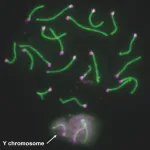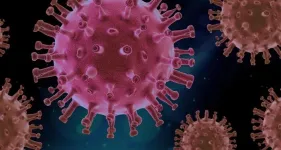(Press-News.org) Rising carbon dioxide levels affect more than just the climate; they also affect the chemistry of the oceans. When saltwater absorbs carbon dioxide, it becomes acidic, which alters the aquatic animal ecosystem. But how exactly does ocean acidification impact animals whose genetic makeup can shift depending on environmental cues? A study published in ACS’ Environmental Science & Technology addresses this question through the “eyes” of oysters.
Oysters, unlike mammals and birds, do not have chromosomes that dictate their sex at the point of fertilization. The bivalves rely on environmental factors to trigger genetic signals that determine whether they are male or female — a mechanism known as environmental sex determination. Previous studies have explored how environmental signals such as temperature and food availability can change female-male ratios for aquatic animals, but shifting pH levels have been overlooked. So, a research team led by Xin Dang and Vengatesen Thiyagarajan examined how ocean acidification could impact the sex ratio of oysters across generations, both in hatcheries and in the wild.
The researchers collected the study’s first generation of oysters from the wild and housed them in two different tanks, one with a neutral pH and the other with slightly more acidic water to mimic ocean acidification. The wild oysters’ offspring (second generation) in the acidic tank had a higher female-male ratio than those spawned in the neutral pH tank.
Next, they transplanted the second-generation oysters from the acidic tank into two different natural habitats: one with a neutral pH and one with an acidic pH. The third-generation oysters had higher female-male ratios regardless of habitat pH, demonstrating that pH-mediated sex determination can be transgenerational for oysters.
Likewise, pH-mediated sex determination also occurred in the control-group offspring. When second-generation control-group oysters were transplanted into acidic natural habitats, their offspring had higher female-male ratios than control-group oysters transplanted into neutral pH natural habitats.
The team also explored the relationship between pH and sex determination through a genetic analysis. The results indicated that a series of genes involved in female development turned on in response to acidic pH, whereas a different set of genes involved in male development shut down. These results uncover a new trigger for environmental sex determination in oysters.
“This study is the first to document a biased sex ratio over multiple generations towards females driven by exposure to low pH,” says Dang. “The results expand our understanding of environmental sex determination and highlight the possible impact of future global changes on reproduction and population dynamics of mollusks and other marine organisms.”
The researchers’ next steps involve exploring this phenomenon in other marine animals, to better understand the genetic regulation in response to climate change and test the application of pH sex determination in oyster aquaculture.
The authors acknowledge funding from the University Grants Committee General Research Fund, Hong Kong’s Sustainable Fisheries Development Fund, the National Key Research and Development Program of China, the National Science Foundation of China, and the Nansha District Science and Technology Program in Key Areas.
###
The American Chemical Society (ACS) is a nonprofit organization founded in 1876 and chartered by the U.S. Congress. ACS is committed to improving all lives through the transforming power of chemistry. Its mission is to advance scientific knowledge, empower a global community and champion scientific integrity, and its vision is a world built on science. The Society is a global leader in promoting excellence in science education and providing access to chemistry-related information and research through its multiple research solutions, peer-reviewed journals, scientific conferences, e-books and weekly news periodical Chemical & Engineering News. ACS journals are among the most cited, most trusted and most read within the scientific literature; however, ACS itself does not conduct chemical research. As a leader in scientific information solutions, its CAS division partners with global innovators to accelerate breakthroughs by curating, connecting and analyzing the world’s scientific knowledge. ACS’ main offices are in Washington, D.C., and Columbus, Ohio.
Registered journalists can subscribe to the ACS journalist news portal on EurekAlert! to access embargoed and public science press releases. For media inquiries, contact newsroom@acs.org.
Note: ACS does not conduct research but publishes and publicizes peer-reviewed scientific studies.
Follow us: X, formerly Twitter | Facebook | LinkedIn | Instagram
END
Images
More than a third of Detroit residents (36%) can't get from place to place in a safe or timely manner.
This is the main finding of a new study led by Alexandra Murphy, associate director of social science research at Mcity and assistant research scientist at U-M's Poverty Solutions, and first author Lydia Wileden, a U-M alum and assistant research professor at the University of Connecticut.
They measured this with a tool created by Murphy and her team called the Transportation Security ...
Researchers led by electrical engineers at the University of California San Diego have developed a better way to perform the comparative analysis of entire genomes. This approach can be used to study relationships between different species across geological time scales.
This new approach is poised to unlock discoveries regarding how evolution has shaped present-day genomes and also how the tree of life is organized. The new method, named CASTER, is described in a paper published in Science on 23 January 2025.
CASTER ...
Researchers at the Crick have uncovered which genes on the Y chromosome regulate the development of sperm and impact fertility in male mice. This research could help us understand why some men don’t produce enough sperm and are infertile.
Males typically have one copy of the Y chromosome and one copy of the X chromosome, whereas females typically have two X chromosomes. Scientists know that the Y chromosome is essential for male fertility, but which genes are the most important and how they work is less clear.
In research published today in Science, a research team at the Crick resolved this question by generating thirteen different ...
Male ruff sandpipers engaging in the act of mating typically fall into one of three groups, with variations in how aggressive they are and how showy their plumage is, among other factors. Now, a new study reports a single gene – HSD17B2 – drives these dramatic differences among male ruff sandpiper morphs. The findings show how evolutionary changes in a single gene's structure, sequence, and regulation can drive significant diversity within a single species. The androgen testosterone plays a key role in male reproductive development. It influences ...
In a new study involving whole-genome data, researchers present “CASTER,” a tool that uses arrangements in DNA sequences known as site patterns to infer “species trees,” which are diagrams that depict the evolutionary relationships among species. The tool, which performs with exceptional accuracy and scalability and overcomes the limitations of traditional phylogenetic methods, offers transformative potential for evolutionary research. The growing availability of genomic data has revitalized efforts to construct precise species trees and model gene tree variations. However, the methodology for utilizing genome-wide data lags behind data availability. While traditional ...
Reforestation is a win-win for climate and wildlife, but large-scale afforestation and bioenergy cropping may do more harm than good, according to a new study of land-based climate mitigation strategies (LBMS) for over 14,000 species. The findings emphasize the need to ensure well-intentioned climate action does not exacerbate biodiversity loss. While reducing greenhouse gas emissions is critical, increasing atmospheric carbon removal is equally essential to effectively combat climate change. LBMS considered among the most scalable ...
The vertical migration of Antarctic krill may play a smaller role in oceanic carbon storage than previously believed, according to a year-long study in the Southern Ocean. The findings challenge conventional assumptions about the animal’s role in deep ocean carbon sequestration and underscore the need for more nuanced biogeochemical models incorporating ecological complexity. “Antarctic krill play an important role in the biological carbon pump, but without observational data, we risk using inaccurate and misleading assumptions about behaviors that influence carbon export and ...
While child deaths in England fell temporarily during the COVID-19 pandemic, they have now risen to new heights, a new study from researchers at the University of Bristol and based on unique National Child Mortality Database (NCMD) data has found.
The study, published in PLOS Medicine today [23 January], has shown that children were less likely to die during the pandemic lockdown (April 2020–March 2021) than at any time before or since, with 377 fewer deaths than expected from the previous year.
The number of deaths in the following year (2021-2022) was similar to before the pandemic, but in 2022−2023, there were 258 more deaths than expected from the pre-pandemic ...
A single gene that regulates testosterone levels in a “crazy” species of shore bird controls the development of three wildly different types of males, an international study involving researchers at Simon Fraser University has found.
Ruffs have long fascinated scientists for their three types of males, known as morphs, that differ radically from each other in appearance and mating behaviours.
A new study published on the cover of the journal Science this month has discovered that these morphs are produced by a super enzyme (HSD17B2) ...
Two-thirds of people with post-COVID-19 syndrome have persistent, objective symptoms – including reduced physical exercise capacity and reduced cognitive test performances – for a year or more, with no major changes in symptom clusters during the second year of their illness, according to a new study published January 23rd in the open-access journal PLOS Medicine by Winfried Kern of Freiburg University, Germany, and colleagues.
Self-reported health problems following SARS-CoV-2 infection ...


